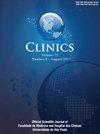TeleHCV: A single-visit protocol and minimal passive remote monitoring are sufficient to achieve high SVR with a sofosbuvir-velpatasvir regimen
IF 2.4
4区 医学
Q2 MEDICINE, GENERAL & INTERNAL
引用次数: 0
Abstract
Aim
Chronic Hepatitis-C Virus (HCV) treatment has evolved significantly in recent years with Direct-Acting Antivirals (DAAs). The traditional care cascade includes several steps that limit its impact, and simplification protocols have emerged. Therefore, the authors explore a simplified treatment strategy for HCV in a healthcare system with limited access to specialized care.
Subject and methods
Chronic HCV, DAA-naïve patients waiting for in-person specialized care were invited to a single-arm non-inferiority trial to evaluate a simplified treatment protocol with a single face-to-face appointment and minimal monitoring of antiviral therapy. The unique visit consisted of an HCV presentation followed by individual medical consultation, blood tests, and delivery of sofosbuvir-velpatasvir pills for a 12-week treatment. Patients were remotely monitored without scheduled on-treatment appointments or phone calls. After treatment, teleconsultation using video was offered. The primary outcome was Sustained Virological Response (SVR) 12-weeks post-treatment. It was analyzed with Intention-To-Treat (ITT) and Per-Protocol (PP) approaches. ClinicalTrials.gov: NCT04039698.
Results
The authors included 144 patients, of which 54.2 % were male, mean age was 52 years. Most individuals (84.7 %) had an APRI score < 1. All patients received at least one dose of DAA, 139 completed antiviral therapy, and 131 had SVR evaluation. The ITT SVR rate was 90.3 % (130/144 patients; 95 % CI 84.2 %‒94.6 %), and the PP SVR was 99.2 % (130/131 patients; 95 % CI 95.8 %‒100 %). Eighty-three adverse events were reported, and 93 % were handled with remote care.
Conclusion
This simplified strategy achieved a high SVR rate in a population with restricted access to specialized care. Telehealth tools and minimal monitoring are promising components for policies aimed at HCV elimination.
TeleHCV:单次就诊方案和最小的被动远程监测足以实现sofosbuvir-velpatasvir方案的高SVR
近年来,直接作用抗病毒药物(DAAs)在慢性丙型肝炎病毒(HCV)治疗方面取得了显著进展。传统的护理级联包括几个限制其影响的步骤,简化协议已经出现。因此,作者探索了一种简化的HCV治疗策略,在医疗保健系统中获得专业护理的机会有限。研究对象和方法:慢性HCV, DAA-naïve等待专人专门护理的患者被邀请参加一项单臂非劣效性试验,以评估一种简化的治疗方案,即单次面对面预约和最少的抗病毒治疗监测。这次独特的访问包括HCV介绍,随后进行个人医疗咨询,血液检查,并给予sofosbuvir-velpatasvir药丸12周的治疗。患者在没有安排治疗预约或电话的情况下进行远程监控。治疗后进行视频远程会诊。主要终点是治疗后12周的持续病毒学反应(SVR)。采用意向治疗(ITT)和按方案(PP)方法进行分析。ClinicalTrials.gov: NCT04039698。结果144例患者,男性54.2%,平均年龄52岁。大多数个体(84.7%)有APRI评分<;1. 所有患者均接受至少一剂DAA治疗,139例完成抗病毒治疗,131例进行SVR评估。ITT SVR率为90.3%(130/144例;95% CI 84.2% - 94.6%), PP SVR为99.2%(130/131例;95% ci 95.8% - 100%)。报告了83例不良事件,其中93%采用远程护理处理。结论该简化策略在专科治疗受限人群中获得了较高的SVR率。远程医疗工具和最低限度的监测是旨在消除丙型肝炎病毒的政策的有希望的组成部分。
本文章由计算机程序翻译,如有差异,请以英文原文为准。
求助全文
约1分钟内获得全文
求助全文
来源期刊

Clinics
医学-医学:内科
CiteScore
4.10
自引率
3.70%
发文量
129
审稿时长
52 days
期刊介绍:
CLINICS is an electronic journal that publishes peer-reviewed articles in continuous flow, of interest to clinicians and researchers in the medical sciences. CLINICS complies with the policies of funding agencies which request or require deposition of the published articles that they fund into publicly available databases. CLINICS supports the position of the International Committee of Medical Journal Editors (ICMJE) on trial registration.
 求助内容:
求助内容: 应助结果提醒方式:
应助结果提醒方式:


